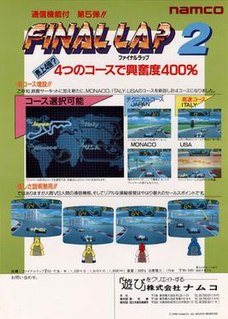
Zero Wing is a 1989 side-scrolling shooter arcade video game developed by Toaplan and originally published in Japan by Namco and in North America by Williams Electronics. Controlling the ZIG space fighter craft, players assume the role of protagonist Trent in a last-ditch effort to overthrow the alien cyborg CATS. It was the eighth shoot 'em up game from Toaplan, and their fourteenth video game overall.

Pole Position is an arcade racing simulation video game that was released by Namco in 1982 and licensed to Atari, Inc. for US manufacture and distribution, running on the Namco Pole Position arcade system board. It is considered one of the most important titles from the golden age of arcade video games. Pole Position was an evolution of Namco's earlier arcade racing electro-mechanical games, notably F-1 (1976), whose designer Sho Osugi worked on the development of Pole Position.
Racing games are a video game genre in which the player participates in a racing competition. They may be based on anything from real-world racing leagues to fantastical settings. They are distributed along a spectrum between more realistic racing simulations and more fantastical arcade-style racing games. Kart racing games emerged in the 1990s as a popular sub-genre of the latter. Racing games may also fall under the category of sports video games.
A sports video game is a video game that simulates the practice of sports. Most sports have been recreated with a game, including team sports, track and field, extreme sports, and combat sports. Some games emphasize actually playing the sport, whilst others emphasize strategy and sport management. Some, such as Need for Speed, Arch Rivals and Punch-Out!!, satirize the sport for comic effect. This genre has been popular throughout the history of video games and is competitive, just like real-world sports. A number of game series feature the names and characteristics of real teams and players, and are updated annually to reflect real-world changes. The sports genre is one of the oldest genres in gaming history.

Virtua Racing, or V.R. for short, is a Formula One racing video game developed by Sega AM2 and released for arcades in 1992. Virtua Racing was initially a proof-of-concept application for exercising a new 3D graphics platform under development, the "Model 1". The results were so encouraging that Virtua Racing was fully developed into a standalone arcade title.

Flicky is a platform game developed by Sega and released in arcades in May 1984. It was licensed to Bally Midway for distribution in the United States. In Flicky, the player controls the eponymous blue bird and must gather all the small birds called Chirps in each round and bring them safely to the exit. There are cat and lizard enemies which can disperse the Chirps and kill the player, but Flicky can use items on the playing field to protect herself and the Chirps from danger.

Hang-On is an arcade racing game released by Sega in 1985 and later ported to the Master System. In the game, the player controls a motorcycle against time and other computer-controlled bikes. It was one of the first arcade games to use 16-bit graphics and uses the Super Scaler arcade system board, created with design input from Yu Suzuki, as technology to simulate 3D effects. The deluxe cabinet version also introduced a motion-controlled arcade cabinet, where the player's body movement on a large motorbike-shaped cabinet corresponds with the player character's movements on screen.

Sega Classics Arcade Collection is the name of two compilations released for the Sega CD. Despite their titles, both versions of Sega Classics Arcade Collection include only the Sega Genesis ports of all the games included.

Bonanza Bros. is a 3D-style, 2D side-scrolling stealth action game developed and released by Sega in 1990. It is one of the earliest arcade games powered by the Sega System 24 arcade system board. It was ported to various home systems, including the Mega Drive/Genesis, Master System, PC-Engine/TurboGrafx-CD, and several home computers.

Rad Mobile is a racing arcade game developed by Sega AM3 and published by Sega. It was first published in Japan in October 1990, followed by an international release for arcades in February 1991. Rad Mobile was Sega's first 32-bit game, using Sega's System 32 arcade system board. It was also the first appearance of Sonic the Hedgehog, who appears as an ornament hanging from the driver's rearview mirror.

Coca-Cola: Suzuka 8 Hours is a 1992 motorcycle racing arcade game developed and published by Namco. It is based on the homonymous real-world racing event. Players control a racer using a handlebar controller and must race against computer-controlled opponents while remaining in first place. It ran on the Namco System 2 arcade hardware. A direct sequel, Suzuka 8 Hours 2, was released a year later.

Kyūkai Dōchūki is a baseball arcade game that was released by Namco in 1990 in Japan; it runs on Namco System 2 hardware, and is a spin-off of Yokai Dochuki. The gameplay is similar to that for Namco's own World Stadium series - except that both players have a total of thirty-six different teams to choose from in the Japanese, Arabic, German, Humbaba, American, Russian, and Chinese leagues. The Japan League has five stadiums, and if the first player selects one team from it, it will randomly decide which one the match will take place in; however, the other leagues only have one stadium, This game also features a cameo re-appearance, from Valkyrie, who appears to report the final outcome of a match once it has finished, and Namco's signature character Pac-Man can also be seen on two of the television screens in her studio wearing a purple bow tie.

Final Lap 2 is an racing simulation game released by Namco for arcades in 1990. It is the arcade sequel to Final Lap and runs on Namco System 2 hardware.

F1 is a 1993 racing video game published by Domark, based on Vroom, a game developed in 1991 for the Atari ST by French company Lankhor. It was released for the Mega Drive/Genesis, Master System, Game Gear, and Amiga. It spawned a sequel in 1994 titled F1 World Championship Edition, and the game engine was reused in Kawasaki Superbike Challenge. It was one of the most popular racing games in the console, mostly thanks to the smooth and fast game engine.

Ace Driver is a 1994 racing arcade game developed and published by Namco. The player controls a Formula One racer, with the objective being to complete three laps of a race course and to avoid a collision with opponents and other obstacles. Three difficulty levels are available, as is a mode to enable a gear shift. Similar to Namco's own Final Lap series, the arcade cabinet can be linked together with another unit to enable eight-person multiplayer. It ran on the Namco System 22 arcade hardware.

Air Buster is a 1990 horizontal-scrolling shooter arcade game developed by Kaneko. It was published by Namco in Japan and Sharp Image Electronics in North America. Two players control the "Blaster Fighter" star ships in their efforts to destroy a mysterious mechanical fortress orbiting Earth, with plans to take control of the planet. The Blaster Fighters can equip one of seven available weapons, which will change the ship's firepower and abilities, such as diagonal shots, homing missiles and small drones that follow the player's ship.

Ayrton Senna's Super Monaco GP II is an arcade-style Formula One racing video game developed and manufactured by Sega for the Sega Genesis and Mega Drive, Master System, and the Game Gear in 1992. It is a follow-up to Super Monaco GP. The game was also endorsed by, and had technical input from, the then-Formula One champion Ayrton Senna. Gameplay includes a World Championship season featuring recreations of the tracks in the 1991 Formula One World Championship, along with a three-race "Senna GP" mode set on fictional tracks.

Super Monaco GP is a Formula One racing simulation video game released by Sega, originally as a Sega X Board arcade game in 1989, followed by ports for multiple video game consoles and home computers in the early 1990s. It is the sequel to the 1979 arcade game Monaco GP. The arcade game consists of one race, the Monaco Grand Prix, but later ports added more courses and game modes based on the 1989 Formula One World Championship.
Ever since Pole Position in 1982, Formula One (F1) has always played a part of the racing genre in video games. Early Formula One games were typically arcade racing games, before Formula One Grand Prix (1991) popularized Formula One racing simulations on home computers.

M2 Co., Ltd. is a Japanese video game developer and publisher, best known for handling emulation of re-released games, such as some Sega Ages titles, Virtual Console titles for Nintendo systems, the 3D Classics series for the Nintendo 3DS and their ShotTriggers range of classic STG games. M2 has also created entirely new titles such as WiiWare games for Konami under the ReBirth moniker and more recently a new GG Aleste game.


















